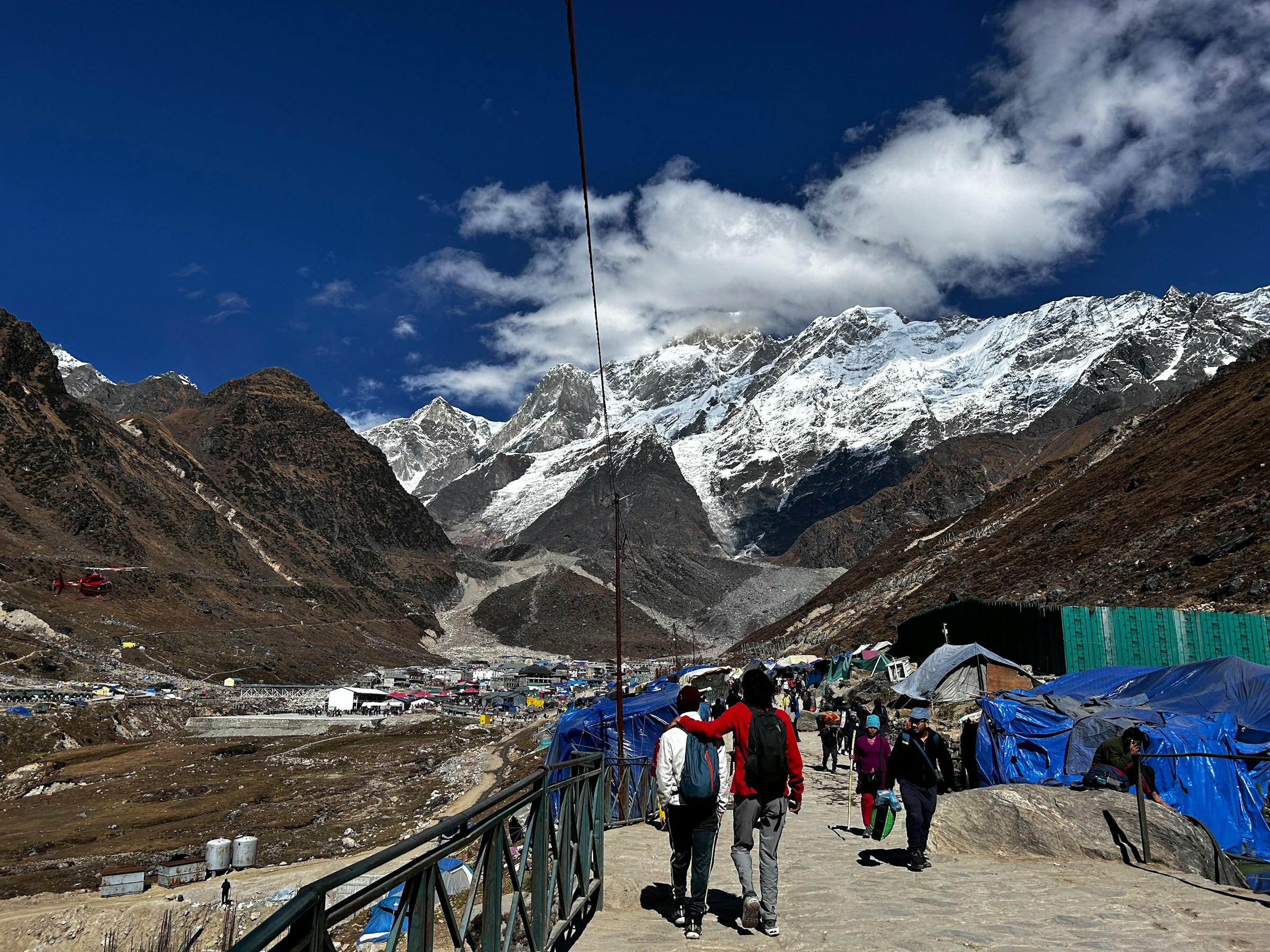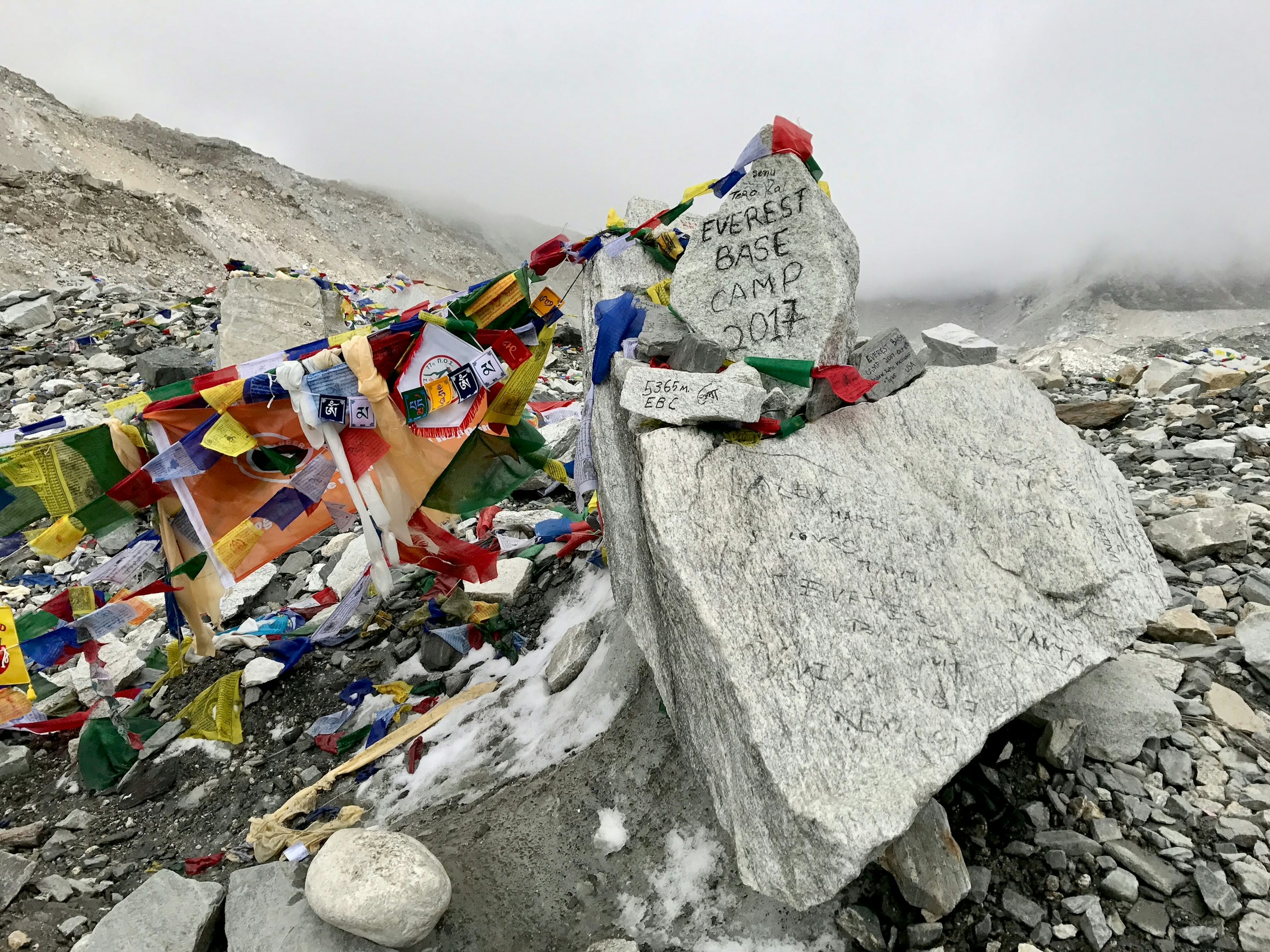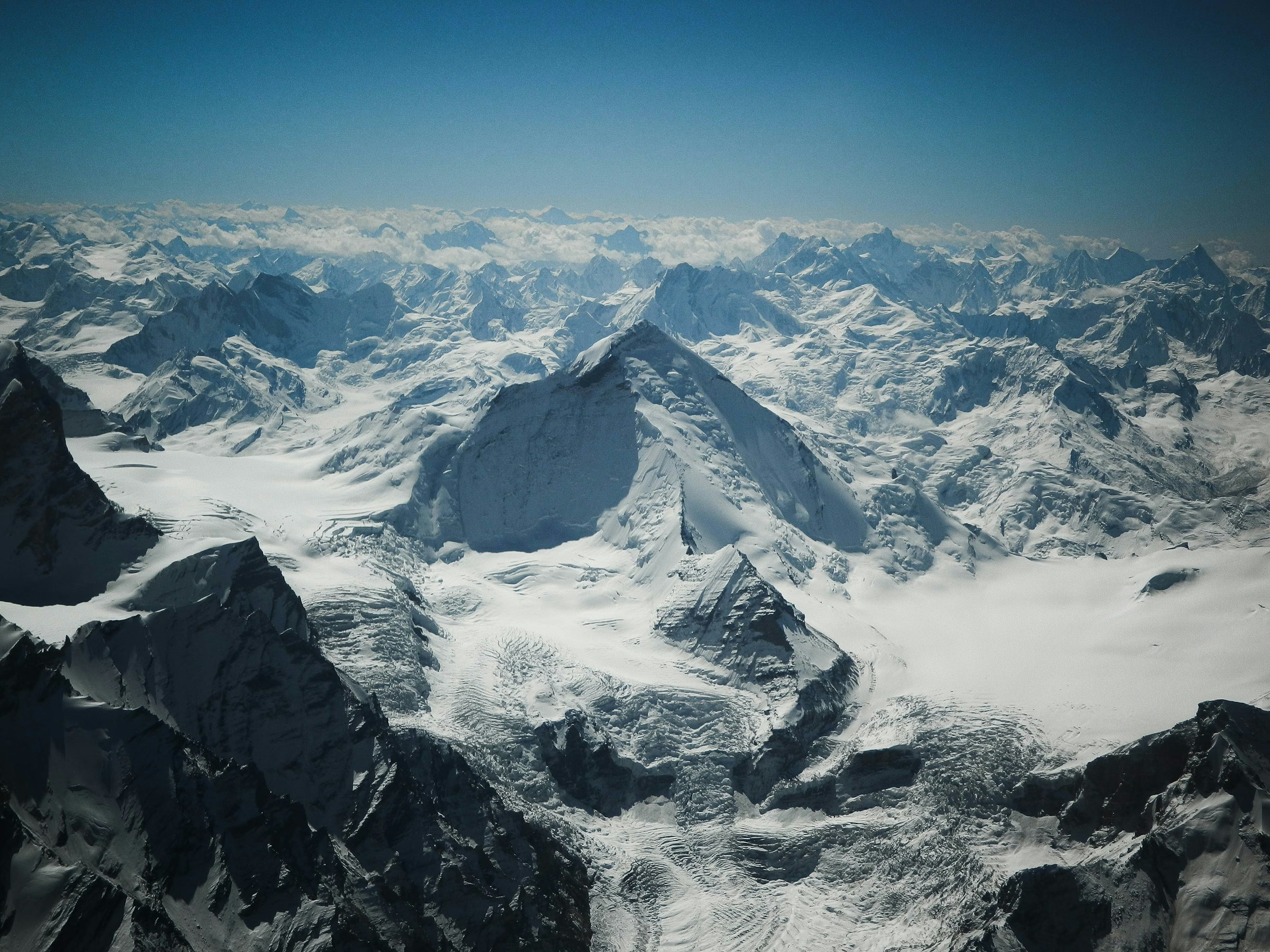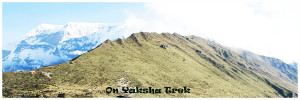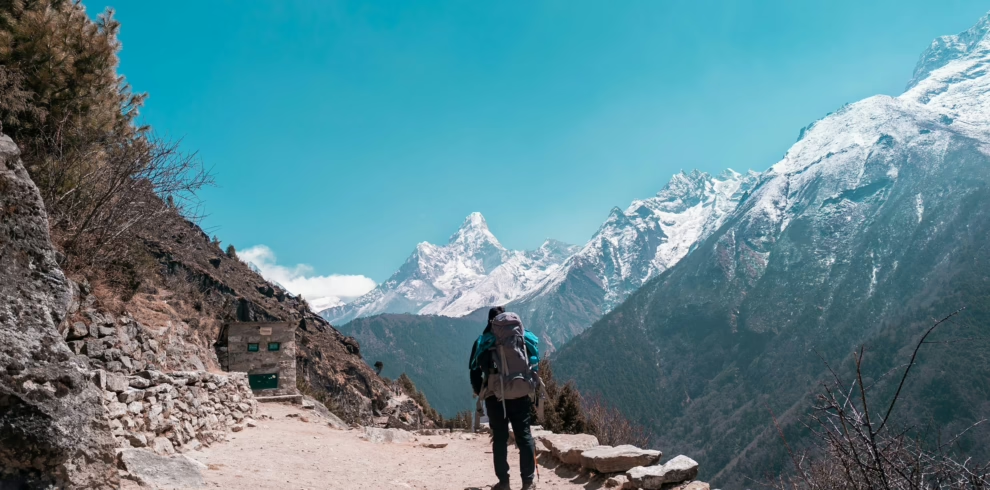Conquer the Himalayas Differently — Three High Passes Trek by Road (19 Days)
Skip the Lukla flight and take the scenic overland route with Green Valley Nepal Treks’ Three High Passes Trek by Road, a 19-day epic designed for true adventurers. This route challenges you with three legendary passes — Kongma La (5,535m), Cho La (5,420m), and Renjo La (5,360m) — and rewards you with unmatched views of Everest, Lhotse, Makalu, Ama Dablam, and beyond.
Along the way, discover the stunning Gokyo Lakes, summit viewpoints like Kalapathar, Gokyo Ri, and Chukkung Ri, and immerse yourself in Sagarmatha National Park, home to elusive species such as Musk Deer and Red Pandas.
Blending raw Himalayan landscapes with authentic Sherpa culture, this trek includes visits to Tengboche Monastery and welcoming teahouse stays that bring warmth to even the most rugged days.
Now booking for 2025 and 2026 — with flexible customization options to tailor the adventure to your pace and interests. If you’re looking for a road-accessible route that doesn’t compromise on challenge or beauty, this is it.
19 days / 18 nights Everest Three High Passes trip
Sacred Paths of the Everest Region
Highlights
- Scenic overland journey from Kathmandu to Thamdanda, skipping the Lukla flight.
- Cross three major Everest region passes: Cho La (5,420m), Renjo La (5,360m), and Kongma La (5,535m).
- Explore the less-traveled Gokyo Valley and the picturesque Thame Valley.
- Witness five of the world’s highest peaks — including Everest, Lhotse, Makalu, Cho Oyu, and Nuptse — from a single trek.
- Trek through Salleri, Phaplu, Kharikhola, and Paiya, experiencing authentic Rai and Sherpa culture.
- Journey through one of Nepal’s finest cross-country trekking routes.
- Enjoy panoramic views of Everest and neighboring peaks from various vantage points.
- Catch breathtaking sunrise views of Mt. Everest from Kala Patthar.
- Encounter diverse wildlife and alpine flora within Sagarmatha National Park, a UNESCO World Heritage Site.
- Visit the serene and spiritual Thamo Monastery, a hidden gem of the Khumbu.
Itinerary
The Three High Passes Trek by Road starts early in the morning after breakfast with a scenic 13–14 hour Jeep drive from Kathmandu to Thamdanda, covering approximately 330 km. The journey begins with a 5-hour drive along the Puspalal Highway, following the Sunkoshi River to reach Ghurmi.
From Ghurmi, the route continues through lush farmland, riversides, and traditional villages—offering a rich travel experience that flying cannot match. After another 7–8 hours by Jeep via Salleri, you’ll arrive at Thamdanda.
End the day at a local teahouse, reflecting on your first achievement and looking forward to the adventure ahead.
The 22 km trek from Thamdanda (2,326 m) to Phakding (2,640 m) takes about 7 to 8 hours. After a 2-hour walk along the Dudh Koshi River, you’ll reach the charming Sherpa village of Paiya.
The trail continues through rhododendron forests, passing Chheplung and Surke, with some steep sections and suspension bridge crossings. From Surke, it's a 2-hour trek to Lukla, a bustling hub where many trekkers begin their Everest Base Camp journey.
From Lukla, a final 2-hour ascent via Nurning and Ghat leads you to Phakding, where you’ll spend the night in a local teahouse.
Today’s trek is scenic, following the Dudh Koshi River and crossing several suspension bridges, including the famous Hillary Bridge. After a few hours of trekking through pine forests, you’ll reach the pleasant village of Monjo.
At Monjo, you’ll check your permits for Sagarmatha National Park before continuing to Jorsalle. The 2-hour climb to Namche Bazaar is steep and challenging but rewarding. Namche, nestled on a mountain slope, is a vibrant town filled with trekkers, shops, and bakeries.
You’ll enjoy views of Thamserku and glimpses of Everest’s towering peaks along the way. The rest of the day is perfect for exploring Sherpa culture, perhaps catching the sunset at the National Park Viewpoint. You’ll overnight in a cozy teahouse in Namche Bazaar.
Explore Namche, the bustling hub of the Khumbu region, where you'll find government offices, an internet cafe, ATMs, restaurants, shops, and more. It’s a lively market town with plenty of services.
For acclimatization, hike to the Everest View Hotel, offering stunning views of Everest, Lhotse, and Ama Dablam. Along the way, visit the Sherpa Culture Museum and Syangboche Airstrip.
Another highlight is Khumjung village, home to the Khumjung Monastery and the famous 'Yeti scalp.' You’ll also visit the Sagarmatha National Park Visitor Center, where you can learn about the area’s rare flora and fauna, as well as the history of Everest climbers and Sherpa hospitality.
Leaving Namche, you'll enjoy stunning views of Everest, Thamserku, and Ama Dablam as you walk towards Tengboche. The trail descends to Phunki Tenga, follows the Imja Khola, and then begins a steep climb through dense forest to Tengboche.
Along the way, look out for Himalayan Thar and Monals. Tengboche Monastery offers breathtaking views of Everest, Lhotse, and Ama Dablam.
In Tengboche, relax in a peaceful community and enjoy the majestic peaks from your window view.
The trek from Tengboche to Dingboche takes a few hours, passing through forests and crossing a bridge over the Imja Khola to reach the cliffside village of Pangboche, home to endangered species like the Musk Deer and Daphne.
Continuing on, you'll walk for about 3 hours through Somare, a charming village surrounded by trees and shrubs. Along the way, you'll pass ancient mani walls and stupas. After 2-3 more hours of trekking, you'll arrive in Dingboche.
The route offers stunning views of Ama Dablam and Tabuche peaks. A restful night in Dingboche's teahouses is highly recommended.
The Three High Passes Trek by Road continues from Dingboche to Chhukung with a 3-4 hour hike. Following the Imja Khola Valley and glacial moraines, you'll reach Yak Bibre.
A short 30-minute hike from Bibre brings you to Chhukung, where you'll be treated to stunning views of the snow-covered Chhukung Ri, Ama Dablam, and Amphu Gyabjen. Spend the night in a cozy teahouse in Chhukung, with the glacier and surrounding peaks as your backdrop.
Today is a rest day to allow your body to adjust to the altitude. For a light warm-up, take a short hike to Chhukung Ri (5,550 meters) for stunning views of Makalu, Baruntse, and Island Peak.
The vistas are breathtaking, and gaining a bit of altitude will help prepare you for the next stage of the trek.
The hike from Chhukung to Lobuche via Kongma La Pass, the highest pass on the Three High Passes Trek, is the longest day of the journey, taking 8 to 9 hours to complete.
The descent to Bibre is challenging, with exposed rocks and a long walk across the vast Khumbu Glacier. The high elevation after crossing Kongma La (5,540 m) adds to the difficulty.
At the top of the pass, you’ll be rewarded with stunning views of Mt. Makalu, Ama Dablam, Lhotse, and Nuptse. After crossing glacial streams and trekking through the rocky moraine field, you’ll reach Lobuche, where you can enjoy a well-deserved rest and a beautiful sunset view from Lobuche Peak.
After crossing the highest pass, Kongma La, you will trek from Lobuche across the Khumbu Glacier to Gorakshep. This relatively short day takes 3 to 4 hours, offering stunning views of peaks like Pumori, Mahalangur, Lingtern, Khumbutse, and Nuptse.
After a brief ascent from Thangma Riju, you'll reach Changri Glacier and Gorakshep Tsho, with panoramic views of snow-capped peaks including Changri, Nuptse, and Lobuche.
As you pass memorials dedicated to Indian Army mountaineers, you'll gain an appreciation for the dangerous trail leading to the Khumbu Icefall. Upon reaching Everest Base Camp, you'll be greeted by vividly colored tents and large groups of trekkers.
Everest Base Camp is the highlight of the day. Afterward, you'll descend to Gorakshep for a well-earned rest.
Kala Patthar offers a great early morning trek with panoramic views of Mount Everest at sunrise.
The 2-3 hour trek to Kala Patthar rewards you with stunning 360-degree views of Everest, Lhotse, Nuptse, Pumori, Ama Dablam, Khangtegra, Lobuche Peak, Base Camp, the Khumbu Glacier, and the Icefall.
Take time to capture unforgettable photos of the snow-capped peaks. After enjoying the views, return to Gorakshep and continue your trek to Dzongla, a village at the base of Cho La Pass, retracing the path through Lobuche.
The trail to Dzongla is relatively smooth but requires attention. You’ll rest here before tackling Cho La Pass.
The trek from Dzongla to Thagnak via Cho La is the most challenging section of the Three High Passes Trek by Road. Starting early, you’ll cross a wooded spur from Dzongla, offering views of Cholatse, Lobuche East and West, and Chola Lake.
The ascent is tough, especially in exposed sections, with glaciated terrain and steep, icy trails. From the top of Cho La Pass, you’ll be rewarded with stunning views of surrounding peaks framed by flying prayer flags.
If the rocks are not ice-covered, the descent toward Thagnak is relatively easier. You’ll end the day with a peaceful evening in Thagnak.
After departing the small village of Dzongla, you'll enjoy a short but scenic trek to Gokyo. The trail follows the dramatic Ngozumpa Glacier, the longest in Nepal.
As you approach Gokyo, the path opens up, revealing a stunning series of turquoise lakes, with the third lake (Dudhpokhari) right beside the village. Gokyo offers breathtaking views of surrounding peaks and pristine glacial lakes.
Adding a second acclimatization day on the Three High Passes Trek by Road is crucial for reaching Gokyo Ri. A few hours of walking from Gokyo leads to six lakes, with the fourth lake framed by a towering cliff to the north.
The steep ascent to Gokyo Ri from Gorak rewards you with stunning views of the Himalayan peaks, including Everest, Lhotse, Makalu, Cho-Oyu, Gyachung, and the vast Ngozumpa Glacier.
After walking past the largest azure lake, you'll reach Cho Oyu Base Camp. Whether you continue to the sixth lake depends on your time, energy, and curiosity. Afterward, you'll descend back to Gokyo for a well-deserved rest.
The Three High Passes Trek by Road begins early with a 7.4 km hike from Gokyo to Marulung via Cho La Pass. This trek takes 6 to 7 hours, leading you to Renjo La Pass along the Renjo La trail through Dudh Pokhari.
The hike from Gokyo to Renjo La can be challenging with steep ascents and descents, but the views of Gokyo Lakes, Gokyo Tsho, and Mount Everest are breathtaking.
The descent to Angladumba Tsho offers stunning views of Cholatse, Lobuche, Cho Oyu, and Taboche.
After a few hours of walking through Lumde, you'll arrive at the charming Sherpa village of Marulung, where you'll see Relama Tsho and Renjo Lake. Spend the night in a cozy teahouse in Marulung.
A few hours of descent from Marulung to Tarnga through rhododendron forests and across the Bhote Koshi River leads you toward Namche Bazaar. Along the way, you'll pass Langmuche Khola and the renowned Gompa shrine, with views of the striking Sundar Peak.
You'll also visit Thame, home to one of the oldest monasteries in the Khumbu region. Retracing your steps through Samde, Thamo, and Phurte, you’ll pass the world’s highest power plant and enjoy views of Khari Goma and Laudo Monastery.
The trail then descends through pine forests, adorned with prayer flags, chortens, gompas, and mani stones, before arriving in the vibrant town of Namche. The lively atmosphere and sense of accomplishment make for a rewarding evening.
The trek from Namche Bazaar to Chaurikharka takes about 6 to 7 hours, mostly descending alongside the Dudh Koshi River through tropical forests and Sherpa villages.
Although the route revisits familiar landscapes, the return offers a fresh perspective from the opposite direction.
You’ll pass through scenic villages like Larja Dobhjan, Monjo, Bengkar, Ghat, and Chheplung before reaching a teahouse in Chaurikharka. From there, you may opt for a short 20-minute visit to Lukla, home to one of the world’s most challenging airports.
Today marks the final day of hiking on the Three High Passes Trek by Road itinerary.
After breakfast in Chaurikharka, you’ll take a short 45-minute to 1-hour trek to Surke, followed by a forested ascent to Paiya (Chutok). The trail then descends for about an hour to Thamdanda before gradually leveling out near Khari La.
Upon reaching the teahouse in Thamdanda, your guide will confirm jeep arrangements for your return to Kathmandu the next day.
In the evening, enjoy a celebratory meal with your trekking team to mark the successful completion of your journey.
Today begins with an early start for your jeep journey back to Kathmandu.
The first leg takes you from Thamdanda to Salleri via Kharikhola, Jubing, and Andheri—an adventurous 4–5 hour ride through rugged terrain.
At Salleri, you’ll transfer to another jeep for the 8–9 hour drive to Kathmandu, enjoying scenic landscapes along the way. You’ll arrive in the evening and spend the night in Kathmandu before continuing to your next destination.
Includes/Excludes
Cost Includes
- Airport Transfers: Pick-up and drop-off at Kathmandu International Airport.
- Permits: Sagarmatha National Park entry and Pasang Lhamu Rural Municipality local permits.
- Transportation: Private jeep from Kathmandu to Thamdanda and return.
- Trekking Gear: Sleeping bag and trekking poles (on request).
- Souvenirs: Green Lotus Trekking duffle bag (with porter service) and T-shirt.
- Meals: Breakfast, lunch, and dinner during the trek.
- Accommodation: Twin-share rooms with shared toilet during the trek.
- Guide Services: English-speaking, government-licensed trekking guide.
- Guide Insurance: Full insurance coverage for the guide.
- Trekking Map: Everest Region trekking map for the group.
- First Aid: Medical kit available throughout the trek.
- Taxes & Fees: Includes tourist service charge, VAT, government taxes, and official expenses.
Cost Excludes
- International Travel: Airfare, Nepal visa, and travel insurance.
- Meals in Kathmandu: Breakfast, lunch, and dinner while in Kathmandu.
- Accommodation in Kathmandu: Any hotel stays in Kathmandu or extra nights on the trek (due to early arrival, delays, or early return).
- Porter Service: Not included. Porter service available as an add-on for USD 380 for the full trip.
- Tips: Gratuities for the guide and porter (customarily expected on this trek).
FAQs
The 19-day Three High Passes Trek by road begins with a scenic drive from Kathmandu to Thamdanda. The route crosses three major passes—Kongma La, Cho La, and Renjo La—and includes acclimatization stops at Namche Bazaar, Chhukung, and Gokyo to help you adjust to the altitude while enjoying incredible mountain views.
You can find quality maps at trekking agencies like Green Lotus Trekking or outdoor gear shops in Kathmandu. While online maps are helpful, carrying a physical map is highly recommended for navigation in high-altitude areas.
This trek includes panoramic views of Mt. Everest and surrounding peaks from Gokyo Ri and Kalapatthar, cultural encounters with Sherpa communities in Namche Bazaar and the Murulung Valley, and crossing three high passes—Kongma La, Cho La, and Renjo La—via Gokyo Lakes and Everest Base Camp.
The 19-day road-based trek typically costs between USD 1,700 and USD 2,500, covering transportation, meals, and accommodation from Kathmandu.
Yes, solo trekking is possible but not recommended due to the challenging terrain and risk of altitude sickness. If you choose to trek alone, carry a reliable map, compass, and have emergency plans in place.
Yes, starting from Jiri is a great option if you want to extend your adventure. While most trekkers fly to Lukla, the Jiri route adds scenic diversity and cultural richness by following less-traveled trails before joining the main route to the Everest region.
This trek offers one of the most challenging yet scenic routes in the Everest region. By crossing Kongma La, Cho La, and Renjo La, you’ll experience diverse landscapes while avoiding the more crowded paths to Everest Base Camp.
The trek covers approximately 166 kilometers over 18 days, taking you through stunning alpine landscapes and across three high passes: Kongma La (5,535m), Cho La (5,420m), and Renjo La (5,360m).
The Three High Passes Trek—also known as the Everest Three Passes Circuit, Everest Triple Pass Trek, or EBC Three Passes Trek—is the most challenging and diverse trekking route in the Khumbu region. This 19-day adventure crosses three major high-altitude passes: Kongma La (5,535m), Cho La (5,420m), and Renjo La (5,360m), offering a rugged, rewarding journey through the heart of the Himalayas.
While most trekkers fly into Lukla, this road-based itinerary lets you skip the risky Lukla flight, adding an exciting overland journey from Kathmandu to Thamdanda. Traveling by road gives you a unique perspective and a smoother start to your adventure.
Covering all three passes in one trek is no small feat, and that’s what makes this journey so exceptional. Along the trail, you’ll experience breathtaking landscapes and iconic landmarks like Gokyo Lake, Kalapathar (5,545m), Gokyo Ri (5,357m), and Chukkung Ri (5,550m). Throughout the trek, you’ll be treated to panoramic views of Everest, Lhotse, Nuptse, Makalu, Ama Dablam, Cho Oyu, and Pumori.
The route winds through remote valleys, small traditional villages, rhododendron forests, and spiritual sites, including the revered Tengboche Monastery. You’ll pass colorful prayer flags, spinning prayer wheels, and experience the warm Sherpa hospitality in villages like Marulung, Khunde, Khumjung, Pangboche, and Lobuche.
This trek also explores the less-traveled Gokyo Valley, offering a more secluded Himalayan experience. You’ll trek through Sagarmatha National Park, a UNESCO World Heritage Site, home to rare wildlife such as Musk Deer, Red Pandas, blue sheep, Himalayan Tahrs, and various Himalayan pheasants.
Green Lotus Trekking offers a well-structured itinerary with cozy teahouse or lodge accommodations throughout the route. Bookings for 2025 and 2026 are now open, and we’re happy to customize the trek to suit your schedule, fitness level, and budget.
Ready to take on the Three Passes the road less traveled way? Contact us for details on pricing, departures, or to tailor the experience to your needs.
What to Expect from the Three High Passes Trek by Road?
With countless trekking options worldwide, many are crowded, dusty, and chaotic. So, what sets the Three High Passes Trek by Road apart? Simple — it’s a rugged, crowd-free adventure through the heart of the Everest region.
This route takes you away from the busy Khumbu trails and into the high alpine wilderness, crossing three of Nepal’s most demanding and scenic passes: Renjo La, Cho La, and Kongma La. Along the way, you’ll be rewarded with jaw-dropping views of Mount Everest and other Himalayan giants. Friendly Sherpas, peaceful trails, and awe-inspiring landscapes fuel your adventurous spirit every step of the way.
Is the Three High Passes Trek by Road Right for You?
If you’re seeking a physical and mental challenge paired with breathtaking Himalayan scenery, this 19-day trek is a perfect fit. You’ll cross three high-altitude passes and enjoy ever-changing landscapes, from alpine valleys to glacial lakes and iconic viewpoints.
The trek also immerses you in local Sherpa and Rai culture, especially in villages like Jorsalle, Marulung, and Thame. Expect unforgettable views of peaks like Pumori, Lobuche, Ama Dablam, Nuptse, Chhukung Ri, Cholatse, and Tabuche.
However, this trek is not easy. Daily hikes last 6–7 hours on steep, uneven terrain, often at elevations above 5,000 meters. It requires solid physical fitness, a good mental attitude, and adequate preparation. First-timers can still enjoy the trek if they train beforehand, wear the right gear, and travel with an experienced guide.
How to Prepare for the Three High Passes Trek by Road?
While many trekkers fly to Lukla and begin the trail from Namche, this road-based trek begins with an overland journey from Kathmandu to Thamdanda—a more affordable and unique alternative.
1. Build Physical Endurance:
You’ll be hiking through rugged terrain at high altitudes. Prepare with cardio workouts, hiking, running, cycling, and strength training. Drink plenty of water and maintain a nutritious diet. Practice hiking on local trails to build stamina and confidence.
2. Strengthen Mental Resilience:
Altitude, unpredictable weather, and long days on the trail can test your limits. Mental preparedness is key to overcoming fatigue and staying motivated throughout the 19-day journey.
3. Gear Up Properly:
Even with physical and mental readiness, lacking the right gear can make the trek difficult. Pack essentials like:
- Durable trekking boots
- Warm, layered clothing and a rain jacket
- Quality backpack and sleeping bag
- Foam pad and headlamp
- Water filter or purification tablets
- First aid kit and any personal medications
With the right preparation, the Three High Passes Trek by Road offers a truly epic Himalayan adventure—challenging, remote, and incredibly rewarding.
Useful Information for the Three High Passes Trek by Road
Best Time to Trek
The ideal seasons for the Three High Passes Trek by Road are spring (March–May) and autumn (September–November). These months offer dry, stable weather, clear mountain views, and vibrant landscapes, especially during the rhododendron bloom in spring. With warm days and chilly nights, this is the perfect time to enjoy the majestic Himalayas without weather-related interruptions.
During these peak seasons, the Everest region becomes lively with climbers and Sherpa teams setting up camps, turning high-altitude areas into bustling trekking hubs.
Food and Accommodation
You’ll find affordable and satisfying meals along the trail, including a mix of Nepali, Indian, Italian, and Continental options. Common dishes include:
- Breakfast: Porridge, cereals, toast, eggs, tea/coffee
- Lunch/Dinner: Dal Bhat (with free refills), noodles, momo, fried rice, spaghetti, garlic soup, pasta, spring rolls
- Snacks/Drinks: Popcorn, tea, coffee, soft drinks, and alcohol (not recommended while trekking)
Accommodation is available in teahouses and lodges, especially in places like Lukla, Namche Bazaar, Thame, Deboche, and Dingboche. Most offer:
- Shared rooms with single beds
- Blankets, pillows, and foam mats
- Basic heating and limited Wi-Fi
- Extra charges for hot showers, charging devices, and internet access
Tip: Book your accommodation in advance, especially during peak seasons.
Trek Difficulty
The Three High Passes Trek by Road is one of the most demanding treks in the Everest region. It spans 18 days, reaching elevations up to 5,545 meters and covering approximately 166 kilometers.
You’ll trek over rugged, steep, and uneven terrain — including boulders, cliffs, and slippery paths. Expect daily hikes of 6–7 hours, with constant ascents and descents. Along the way, you may face altitude-related challenges like AMS, HAPE, or illness.
This trek is not suitable for beginners. Prior trekking experience in high-altitude environments is highly recommended. However, with proper training, preparation, and a professional guide, the journey is achievable and incredibly rewarding.
Travel Insurance
Comprehensive travel insurance is essential for the Three High Passes Trek. Medical support is limited in remote regions, so coverage should include:
- Emergency helicopter evacuation
- Medical expenses
- Trip interruption/cancellation
- Loss or theft of belongings
Review your insurance policy carefully and carry a hard copy with you.
Packing List
Proper gear is crucial for safety and comfort on this 18-day trek. Here’s a recommended packing list:
- Waterproof and insulated jacket
- Warm gloves and hat
- Raincoat
- Durable hiking boots and socks
- Duffel bag (15–25 kg) and daypack (35–50 liters)
- Warm sleeping bag
- Trekking poles
- Refillable water bottles (1–2 liters)
- Sunscreen and lip balm with SPF
- Sunglasses with UV protection
- Headlamp or flashlight with spare batteries
- First aid kit
- Camera with extra batteries
- Map of the trek and a compass
- Nepalese cash
- Required trekking permits
Reminder: Skimping on gear can lead to injury or worse. Prepare wisely and trek safely.

